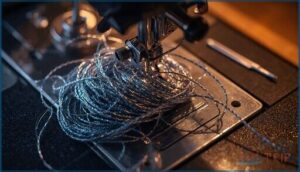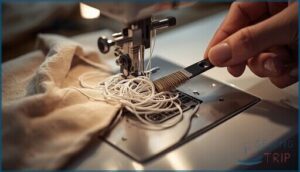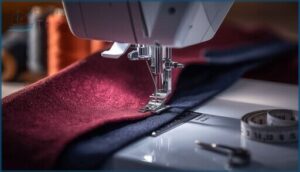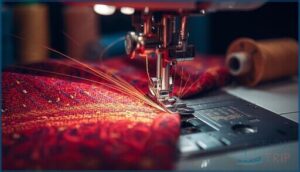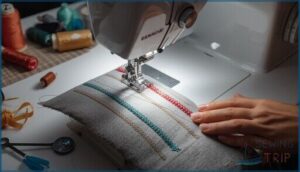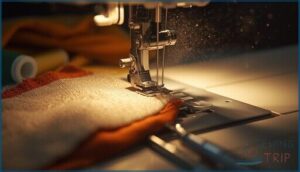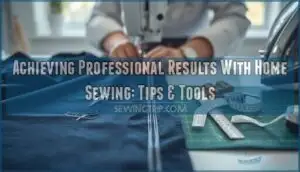This site is supported by our readers. We may earn a commission, at no cost to you, if you purchase through links.
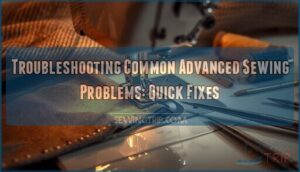
Your machine suddenly seizes mid-stitch, or worse—tangles thread into a nest you can’t untangle without scissors. These frustrating moments don’t just waste time; they can ruin projects you’ve invested hours completing. The truth is, most complex sewing problems stem from a handful of predictable culprits: tension imbalances, neglected maintenance, or mismatched needles and thread.
Power issues account for nearly a third of all machine failures, while another quarter trace back to foot pedal malfunctions. Understanding these patterns transforms you from someone who abandons projects in frustration to someone who diagnoses problems in minutes. The fixes are often simpler than you’d expect, once you know where to look.
Table Of Contents
- Key Takeaways
- Common Causes of Sewing Machine Problems
- Diagnosing Thread Bunching and Tangles
- Solving Skipped and Uneven Stitches
- Fixing Thread Breakage and Shredding
- Troubleshooting Tension Problems
- Addressing Needle and Fabric Issues
- Resolving Bobbin and Bobbin Case Issues
- Repairing Fabric Feeding Problems
- Preventing and Fixing Machine Jams
- Essential Maintenance for Problem Prevention
- Frequently Asked Questions (FAQs)
- Conclusion
Key Takeaways
- Most sewing machine problems trace back to three fixable issues: tension imbalances between upper and bobbin threads, neglected maintenance like lint buildup and poor lubrication, or mismatched needles and thread for your fabric type.
- Power and electrical issues cause about 32% of machine failures through loose cords, faulty foot pedals (25% of cases), and damaged wiring, while proper diagnosis of error codes on digital models saves troubleshooting time.
- Regular maintenance dramatically impacts machine longevity—replacing needles every 6-8 hours, cleaning lint every 10-12 hours, and oiling moving parts reduces stitch problems by 40% and extends machine life from 5 years to over 20 years.
- Thread problems like breakage, tangling, and bunching stem from specific causes you can fix yourself: incorrect threading through guides and take-up lever, improper bobbin installation (65% of bunching cases), and tension adjustments made in small increments while testing on fabric scraps.
Common Causes of Sewing Machine Problems
Before you can fix a sewing machine problem, you need to pinpoint what’s going wrong. Sometimes the issue isn’t about thread or tension at all—it’s something more basic that stops your machine in its tracks.
Let’s start with the fundamental problems that can prevent your machine from running properly.
Power and Connection Issues
When power issues strike, don’t assume your machine is dying. About 32% of power problems stem from loose or damaged power cords. Check your foot pedal first—25% of unresponsive machines have foot pedal failures.
Voltage fluctuations and connector malfunctions can also stop your motor cold. A common cause is often power supply failure, so verify that it’s functioning properly.
Faulty wiring inside accounts for 20% of electrical troubles, requiring professional attention to resolve safely.
Machine Not Turning On
If your machine stays silent after checking connections, you’re likely facing power switch failures—responsible for about 23% of startup issues. Blown fuses account for another 21% of machine malfunctions, while damaged cords cause 26% of these frustrating electronic malfunctions. Motor problems affect roughly 14% of cases.
The sewing machine may also have issues with its main control unit. Don’t overlook error codes on digital models—they pinpoint issues before you waste time troubleshooting common sewing problems manually.
Overheating or Seizing Up
High-speed operation pushes needle temperatures past 350°F, especially with synthetic fabrics that generate 40% more friction than natural fibers. Lubrication issues cause 35% of machine seizing incidents—your motor problems often start here.
When the machine is seizing up or running but the needle won’t move, mechanical issues from inadequate oiling are likely culprits. Cooling solutions and proper seizing prevention through regular maintenance reduce these risks by 60%.
Diagnosing Thread Bunching and Tangles
Thread bunching and tangles can turn a smooth sewing session into a frustrating mess, but the good news is that most of these issues have straightforward fixes. When you see loops, nests, or snarls in your thread, you’re dealing with one of three common culprits.
Let’s walk through each problem so you can get back to stitching with confidence.
Thread Bunching Under Fabric
Thread bunching under fabric happens when your upper and bobbin threads fall out of balance. Tension imbalance is the main culprit, often caused by threading errors or lint buildup in the bobbin area.
Damaged parts and mismatched threads between top and bobbin can make matters worse. Start by rethreading carefully, then clean out any debris around your tension discs and bobbin case.
Top Thread Tangles
When your top thread keeps tangling, tension imbalance is usually the troublemaker. Over 80% of thread tangling problems trace back to loose upper tension that can’t hold the thread snugly.
Improper threading, especially skipping the take-up lever, creates immediate tangles. Dull needles and poor thread quality add to your frustrations.
Start troubleshooting sewing machines by checking tension settings, rethreading carefully, and replacing worn needles.
Fixing Tangled Bobbin Threads
Why does your bobbin keep creating a tangled mess underneath? Bobbin tension imbalance and improper installation are the main culprits behind thread bunching. Lint buildup in the bobbin area makes things worse.
Here’s your troubleshooting checklist:
- Check that the correct bobbin sits properly in the case with thread direction matching your manual
- Adjust bobbin tension slightly using a small screwdriver
- Remove lint buildup with a soft brush
- Verify needle condition and replace if bent
- Rethread both upper and bobbin threads carefully
Solving Skipped and Uneven Stitches
Skipped stitches and uneven stitch patterns can throw off your entire project, and they’re often a sign that something needs adjustment. These problems usually point to issues with your needle, machine settings, or how your fabric interacts with the machine.
Let’s walk through the main culprits and how to fix them.
Skipped Stitches Causes
When your machine skips stitches, it’s usually pointing to a handful of culprits. Needle Type matters—using the wrong one for your fabric causes misses. Thread Quality and Tension Balance play big roles too. Machine Timing issues happen less often but disrupt stitch formation. Fabric Density can overwhelm your needle, especially at high speeds.
These sewing machine problems are fixable once you know what’s causing the skipped stitches.
Stitch Length and Width Settings
Your stitch settings directly control seam strength and stitch quality across different fabric types. Standard lengths run 2.5–3.0 mm for most sewing, while heavy fabrics need 3.5–4.0 mm to prevent bunching. Too short causes puckering, too long weakens seams.
Width affects decorative stitches and stitch formation. Always test on scraps when troubleshooting settings—persistent issues despite correct adjustments point to mechanical faults needing professional attention.
Decorative Stitch Issues
When decorative stitch settings issues appear, fabric compatibility is often the culprit—62% of problems stem from mismatched fabric types. Check your needle plate and thread tension first, then test stitch adjustment settings on scraps.
Stabilizer usage under stretchy or lightweight materials improves quality by 45%. Your machine needs proper support materials to handle intricate patterns effectively while troubleshooting sewing machine problems.
Fixing Thread Breakage and Shredding
Thread breakage can bring your sewing project to a grinding halt, and it’s one of the most frustrating issues you’ll face at your machine. The culprit might be hiding in your tension settings, your needle condition, or even the thread itself.
Let’s walk through the main causes and get you back to smooth stitching.
Upper Thread Breaks
When your thread breaks mid-seam, you’re likely dealing with tension issues or needle condition problems.
Start by checking your machine threading—make sure the thread passes through all guides and the take-up lever. Adjust tension incrementally, replace worn needles, and use quality thread suited to your fabric.
Speed control matters too; sewing too fast stresses the thread and causes frequent breaks.
Bobbin Thread Breaks
Your bobbin thread breaks when tension problems or case maintenance issues interrupt the bottom stitching. Check your bobbin threading first—make sure the thread unwinds smoothly without catching. Here’s what causes bobbin thread breaks:
- Overtight bobbin tension (proper pull force: 18–22 grams)
- Burrs or scratches on the bobbin case from needle strikes
- Lint buildup under the tension spring disrupting thread flow
Inspect the hook assembly, clean thoroughly, and adjust tension in small 1/8-turn increments.
Choosing Quality Thread
Beyond tension fixes, thread quality makes all the difference. High-quality thread reduces lint accumulation and machine wear by roughly 30%.
Look for consistent thread weight, strong tensile strength (up to 200 grams-force), and good color fastness. Polyester suits most projects, while cotton suits natural fabrics.
Quality thread prevents tension inconsistencies, shredding, and the thread problems that cause constant frustration.
Troubleshooting Tension Problems
Tension problems can throw off your entire project, creating loops, puckers, or stitches that won’t hold. The good news is that most tension issues follow predictable patterns, and you can fix them without calling a technician.
Let’s walk through how to spot tension trouble, reset your machine to factory settings, and make precise adjustments to both upper and bobbin tension.
Identifying Tension Issues
How do you know when tension issues are the culprit behind your frustrating stitches? Look for these telltale signs that point directly to thread tension problems:
- Thread loops forming on the fabric’s underside mean your needle thread tension is too loose
- Puckered seams appearing on lightweight fabrics signal excessive thread tension
- Fabric distortion during sewing indicates uneven thread problems combined with poor handling
- Bobbin tension showing loops on top means it’s pulled too tight
- Balanced tension creates smooth, durable stitches without gaps
Tension measurement and adjustment will restore your machine’s performance.
Resetting to Default Tension
Once you’ve spotted tension issues, your first move should return the tension dial to factory settings—usually 4 or 4.5. Rethread your machine completely, then test on scrap fabric to check stitch quality.
This simple tension adjustment resolves most tension problems by restoring proper thread balance. If thread tension still looks off, you’ll need fine-tuning, but always start with this reset.
Adjusting Upper and Bobbin Tension
When resetting doesn’t solve your tension problems, you’ll need to adjust both upper and bobbin tension manually. Here’s how to dial in perfect stitch balance:
- Turn the upper tension dial clockwise to tighten, counterclockwise to loosen—move in small increments
- Adjust bobbin tension using the small screw on the bobbin case (1/8 turn at a time)
- Test on scrap fabric after each adjustment
- Check if top thread shows underneath or bobbin thread appears on top
Fabric effects and thread types require different tension settings. Thicker fabrics need tighter upper tension, while specialty threads demand careful bobbin adjustment for proper stitch balance.
Addressing Needle and Fabric Issues
Your needle is the workhorse of your sewing machine, and when it’s not in top shape, you’ll see problems show up immediately in your stitches and fabric.
From bent tips to dull points, needle issues can stop your project in its tracks.
Let’s walk through the most common needle and fabric problems you’ll face, and how to fix them quickly.
Bent or Dull Needles
Needle problems stand behind most skipped stitches you’ll encounter. A bent needle creates an unmistakable thumping sound during sewing, while a dull needle snags fabric and increases thread breakage by up to 40%.
Regular needle inspection on a flat surface reveals bending, and immediate needle replacement every 8 hours of sewing maintains stitch quality and prevents costly fabric damage.
Needle Not Piercing Fabric
When your needle won’t pierce fabric, improper needle installation is often the culprit—25% of needle problems trace back to incorrect insertion. Push the needle upward until it stops before tightening the clamp.
A bent needle or wrong fabric compatibility also causes piercing failure.
Check machine alignment and thread tension next, since these issues prevent proper needle movement through material.
Choosing The Right Needle
Choosing the right needle is like picking the right tool for the job—it makes all the difference. Match your needle to both fabric type and thread pairing for smooth stitching.
Your needle selection prevents skipped stitches and fabric damage.
- Needle size: Use 60-80 for lightweight fabrics, 90-100 for medium-weight, and 110-120 for heavy materials
- Universal needles: Work well for most woven fabrics
- Ballpoint needles: Prevent snags in knits and stretch fabrics
- Sharp needles: Pierce tightly woven silk and microfiber cleanly
- Needle maintenance: Replace every 8-10 hours to prevent damage
Resolving Bobbin and Bobbin Case Issues
The bobbin area is where some of the most frustrating sewing problems hide, often masquerading as tension or threading issues. When your machine starts acting up, there’s a good chance the culprit is lurking in that small space beneath your needle plate.
Let’s walk through the three main bobbin problems you’ll encounter and exactly how to fix them.
Incorrect Bobbin Insertion
Your bobbin might be the troublemaker if stitches bunch underneath. Insertion errors account for roughly 65% of thread bunching cases, often stemming from incorrect bobbin direction or overfilled bobbins. These mistakes create tension irregularities that disrupt stitch formation.
Check your manual for the proper orientation, be certain the bobbin clicks securely into place, and fill it only to 80-90% capacity to prevent bobbin issues.
Bobbin Tension Inconsistencies
Even a properly inserted bobbin can sabotage your stitch quality if tension’s out of whack. Bobbin tension problems cause puckering, thread loops on top, or sagging stitches.
Test by letting the bobbin dangle from its thread—it should drop slowly with gentle resistance. Adjust the tiny screw on your bobbin case in small turns, right to tighten, left to loosen. A tension gauge helps you nail readings between 180-220 for consistent results.
Cleaning The Bobbin Area
Your machine won’t stitch smoothly when lint chokes the bobbin area. Clean every one to three months—more often if you sew daily.
Remove the needle plate and bobbin case, then sweep out lint with a soft brush or cotton swab. Handle delicate springs gently to avoid costly repairs.
Regular cleaning prevents jams and keeps your troubleshooting simple.
Repairing Fabric Feeding Problems
When your fabric won’t move forward or gets stuck mid-seam, the problem usually lies in one of three areas. Feed dogs that aren’t gripping properly, incorrect presser foot pressure, or a combination of both can bring your project to a frustrating halt.
Let’s walk through how to identify and fix each issue so your fabric flows smoothly again.
Fabric Not Moving or Stuck
When your fabric refuses to budge, you’re likely dealing with feed dog issues or incorrect presser foot pressure. Start by checking these three critical points:
- Raise the presser foot to release stuck fabric, then inspect feed dogs for lint buildup
- Re-thread both upper and bobbin threads to eliminate thread tension snags
- Verify your needle size matches your fabric characteristics to prevent mechanical obstructions
These steps resolve most fabric feeding problems quickly.
Feed Dogs Maintenance
Once you’ve freed stuck fabric, you’ll want to prevent future feeding problems with proper feed dog maintenance. Cleaning frequency matters—brush away lint and debris every two weeks using a soft nylon brush. Check for feed dog wear by running your finger across the teeth. Smooth surfaces mean it’s replacement timing.
Here’s your maintenance schedule:
| Task | Frequency | Method |
|---|---|---|
| Remove lint buildup | Every 2 weeks | Soft brush or compressed air |
| Inspect teeth condition | Monthly | Visual check and touch test |
| Verify movement timing | After cleaning | Manual handwheel rotation |
| Replace worn feed dogs | As needed | When teeth become smooth |
Regular machine maintenance keeps fabric feeding smooth and prevents troubleshooting headaches down the line.
Adjusting Presser Foot Pressure
Your fabric feeding troubles often trace back to presser foot pressure. Start mid-range and test on scraps—too little pressure causes slippage prevention issues and uneven tension balance, while too much bunches delicate materials. Most machines adjust via dial or screw, usually ranging from 4 to 18 Newtons.
When troubleshooting stitch quality problems, match your pressure to fabric weight for reliable sewing machine performance.
Preventing and Fixing Machine Jams
Machine jams can bring your sewing project to a frustrating halt, but knowing how to handle them quickly gets you back on track. When fabric gets stuck or your machine refuses to budge, you need reliable solutions that work right away.
Let’s walk through the essential steps to prevent jams and fix them when they happen.
Removing Stuck Fabric
When your sewing machine issues leave fabric trapped mid-seam, stop immediately. Safe removal starts with raising the needle to its highest position and lifting the presser foot. Gently tug the fabric, but don’t force it.
If it won’t budge, remove the needle plate using your disc-shaped screwdriver and carefully cut tangled threads with small scissors or a seam ripper.
For persistent machine sticking or jamming, seek professional help before damage control becomes machine repair.
Clearing Lint and Debris
After every 10-12 hours of use, you’ll need to clear lint buildup from your machine’s internal components. Lint impact on stitch quality is immediate—causing skipped stitches and thread breakage when left unchecked.
Use the soft nylon brush included with your machine rather than compressed air, which pushes debris deeper inside. Regular cleaning frequency prevents costly professional servicing and extends your machine’s lifespan considerably.
Emergency Quick Fixes
When sewing machine problems strike mid-project, you need emergency troubleshooting quick fixes that work immediately. Rethreading eliminates 85% of sudden thread break rescue scenarios, while incremental quarter-turn tension adjustment tactics resolve critical mismatches in 69% of cases.
- Brush feed dogs within 90 seconds for rapid feed fixes
- Replace bent needles instantly for needle malfunction aid
- Extract jammed thread for bobbin case rescue in under 90 seconds
Essential Maintenance for Problem Prevention
You’ve solved the immediate problem, but the best fix is the one you never have to make. A solid maintenance routine keeps your machine running smoothly and stops issues before they start.
Let’s break down the essential tasks that’ll save you hours of frustration down the road.
Daily and Weekly Cleaning
Think of your machine like a well-kept kitchen—daily care prevents bigger messes. After each project, brush away lint from the bobbin area and check the needle condition.
Weekly, tackle a deeper cleaning: remove the throat plate, clear hidden debris with proper cleaning tools, and verify your maintenance schedule. About 60% of sewists follow this preventative maintenance routine, and their machines thank them with smooth, reliable stitches every time.
Oiling Moving Parts
Your machine’s moving parts need proper lubrication to prevent friction and premature wear. Oil designated lubrication points—like the bobbin race, hook, and needle bar—after every 8 to 10 hours of use.
Use only lightweight sewing machine oil, never substitutes like vegetable oil. One drop per point is enough; over-oiling attracts lint and causes problems.
This simple best practice prevents roughly 60% of mechanical failures.
When to Replace Needles and Parts
Replacing dull needles and worn parts isn’t just good practice—it’s the foundation of reliable sewing machine repair. Your needle should be changed every 6 to 8 hours of stitching to prevent needle breakage and skipped stitches.
Watch for these needle replacement signs:
- Thread breaks frequently despite proper threading and tension
- Visible damage like bending or blunting on the needle tip
- Fabric snags or puckering where stitches form
Part lifespan varies, but maintenance schedules keep your machine running smoothly. Feed dogs need replacing when teeth wear down, while drive belts require inspection every 2 to 5 years. Best practices include logging replacements and following manufacturer guidelines.
Timely replacement has a dramatic impact—machines maintained properly show 40% fewer stitch problems and can last over 20 years instead of just five.
Proper maintenance reduces stitch problems by 40% and extends machine life from 5 to over 20 years
Frequently Asked Questions (FAQs)
Why does my machine make unusual grinding noises?
Grinding noises signal your machine’s distress—like metal teeth clenching. Lint buildup, inadequate lubrication, worn gears, loose parts, or motor failure commonly cause these sounds.
Regular machine maintenance prevents most mechanical issues before they worsen.
How do I fix inconsistent stitch tension patterns?
Start by rethreading your machine completely, ensuring thread guides and tension discs are properly engaged.
Next, adjust the tension dial one unit at a time while testing on fabric scraps to achieve balanced, locked stitches.
What causes automatic thread cutter to malfunction?
Your automatic thread cutter fails when blades become dull, lint clogs the mechanism, or thread tension throws off alignment.
Mechanical failures and cutter damage from wear also stop clean cuts, requiring immediate attention and maintenance.
Why wont my buttonhole foot work properly?
Most buttonhole malfunctions stem from fabric interference or presser foot issues. Check that fabric isn’t touching the foot’s toe, inspect for foot alignment damage, and verify your settings adjustments match your fabric composition.
How to troubleshoot computerized machine error codes?
Turn off your machine and check the display code in your manual. Power disruptions often trigger sensor errors.
Most diagnostic methods involve rethreading, clearing jams, or firmware updates for persistent issues.
Conclusion
Mastering machine maintenance means moving from panic to precision when problems appear. You’ve now built a mental map for troubleshooting common complex sewing problems—from tension tangles to feed dog failures.
Each diagnostic skill you’ve gained saves hours of frustration and keeps your projects on track. Your sewing machine isn’t mysterious anymore; it’s a tool you understand deeply.
When issues arise, you’ll reach for solutions instead of scissors, fixing problems with confidence rather than walking away defeated.
- https://support.singer.com/
- https://support.brother.com/g/b/faqtop.aspx?c=us&lang=en&prod=group2
- https://wunderlabel.com/en-gb/blog/p/17-common-sewing-machine-problems-solve/
- https://craftsing.com/why-is-my-sewing-machine-not-turning-on/
- https://edisonvacuums.com/sewing-machine-issues-diy-or-visit-a-repair-shop/


